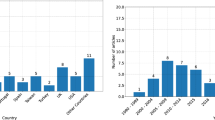Abstract
The unified methods of wear-fatigue tests of models of active systems, which are based on a combination of the known mechanical fatigue, friction and wear test methods, are offered. A bending fatigue test method for a uniform cylindrical specimen with a test portion diameter of 10 mm is adopted as a basic one.
Similar content being viewed by others
References
L. A. Sosnovskii, “The method of wear fatigue tests of power systems and their models,” Int. J. Frict. Wear, 14, No. 5, 937–952 (1993).
K. V. Frolov and N. A. Makhutov, “New test machines and methods,” Zavod. Lab., No. 5, 32–33 (1995).
M. S. Vysotskii, N. A. Makhutov, V. N. Koreshkov, et al., “On development of standard methods for wear-fatigue tests,” Zavod. Lab., No. 5, 35–38 (1995).
N. A. Makhutov, A. V. Bogdanovich, P. V. Andronov, et al., “Methods of wear-fatigue tests and their realisation on the SI machines,” Zavod. Lab., No. 6, 17–42 (1995).
“SI series machines for wear-fatigue tests,” in: L. A. Sosnovskii and M. S. Vysotskii (Eds.), Tribo-Fatigue-95: Annual [in Russian], Tribo-Fatigue Ltd., Gomel (1996).
Author information
Authors and Affiliations
Additional information
__________
Translated from Problemy Prochnosti, No. 1, pp. 121–128, January–February, 2009.
Rights and permissions
About this article
Cite this article
Bahdanovich, A.V., Tyurin, S.A., Andriyashin, V.A. et al. Wear-fatigue test methods and their significance. Strength Mater 41, 95–101 (2009). https://doi.org/10.1007/s11223-009-9104-9
Received:
Published:
Issue Date:
DOI: https://doi.org/10.1007/s11223-009-9104-9




